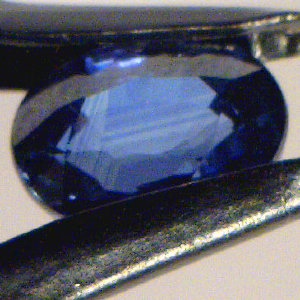- Joined
- Jun 25, 2007
- Messages
- 429
Greetings,
When shopping for a Sapphire of fine quality in a market place there will be many factors to consider but this will only touch on a couple of the factors as complete information could fill a few books.
Usually a fine quality stone will have little or no inclusions visible even when you look with 10x loupe. The first concern when there are no inclusions visible is that it may be a synthetically made Sapphire rather than a Sapphire mined from the ground. Synthetic gems are usually valued much lower than naturals. That is why it is often comforting to find a tiny natural inclusion that we recognize or some color banding that has a 120 degree corner. This type of banding is only seen in a natural Sapphire so if we are sure that there is color banding with this type of corner then we know we are looking at a natural Sapphire, however, look at the attached picture.
In this stone we can clearly see the color banding with the 120 degree corner. Many times this banding will be much lighter and harder to see but I selected this stone so that it can be seen in a photograph. Even though we now know we are looking at a natural Sapphire, we must check the girdle of the stone for a seam. This will require at least 10x magnification. On this particular stone there is a seam barely visible under 10x as this stone is an assembled stone, also known as a doublet. The crown is natural Sapphire and the pavilion is a synthetic Sapphire and they were glued together as rough then faceted so that the seam is hidden on the girdle. This type of stone is designed to fool the gem buyer. Often the crown has lighter banding than this as they want us to believe that we are holding a very fine quality natural Sapphire so we will pay them far too much for their assembled product. I would advise to make a close inspection of the girdle of every Sapphire before buying it, even from a trusted local jeweler as this product has made its way into many fine shops without being detected by the gem buyer of the store. Best regards, Lee
When shopping for a Sapphire of fine quality in a market place there will be many factors to consider but this will only touch on a couple of the factors as complete information could fill a few books.
Usually a fine quality stone will have little or no inclusions visible even when you look with 10x loupe. The first concern when there are no inclusions visible is that it may be a synthetically made Sapphire rather than a Sapphire mined from the ground. Synthetic gems are usually valued much lower than naturals. That is why it is often comforting to find a tiny natural inclusion that we recognize or some color banding that has a 120 degree corner. This type of banding is only seen in a natural Sapphire so if we are sure that there is color banding with this type of corner then we know we are looking at a natural Sapphire, however, look at the attached picture.

In this stone we can clearly see the color banding with the 120 degree corner. Many times this banding will be much lighter and harder to see but I selected this stone so that it can be seen in a photograph. Even though we now know we are looking at a natural Sapphire, we must check the girdle of the stone for a seam. This will require at least 10x magnification. On this particular stone there is a seam barely visible under 10x as this stone is an assembled stone, also known as a doublet. The crown is natural Sapphire and the pavilion is a synthetic Sapphire and they were glued together as rough then faceted so that the seam is hidden on the girdle. This type of stone is designed to fool the gem buyer. Often the crown has lighter banding than this as they want us to believe that we are holding a very fine quality natural Sapphire so we will pay them far too much for their assembled product. I would advise to make a close inspection of the girdle of every Sapphire before buying it, even from a trusted local jeweler as this product has made its way into many fine shops without being detected by the gem buyer of the store. Best regards, Lee







300x240.png)